Contents
- Why cucumbers need superphosphate
- Signs of a lack of phosphorus in cucumbers
- Types of superphosphate
- How to dilute and apply superphosphate for cucumbers
- Feeding time
- Features of top dressing
- Superphosphate for cucumbers during the fruiting period
- Safety measures
- Conclusion
- Reviews on the use of superphosphate for cucumbers
Superphosphate fertilizer for cucumbers is applied throughout the growing season. Phosphorus provides normal growth, strengthens the shoots, which is well reflected in the yield. Superphosphate also deoxidizes the soil, making cucumbers tastier. To apply fertilizer, it is necessary to prepare a concentrated solution based on granules, then dilute it with water and start watering.
Why cucumbers need superphosphate
Cucumbers, like other crops, need a constant supply of phosphorus. It is a vital trace element that ensures normal metabolism in plant tissues. Thereby:
- powerful roots are formed;
- shoots are strengthened;
- productivity increases;
- increases resistance to diseases and insects;
- tissues are saturated not only with phosphorus, but also with other trace elements;
- fruits grow quickly and become more tasty.
Signs of a lack of phosphorus in cucumbers
Phosphorus deficiency adversely affects the development of plants. Signs of an element shortage can be determined visually:
- a sharp slowdown in growth;
- shoots become weak;
- the leaves along the edges acquire a bluish-green or red-violet, even a purple hue (first the lower ones, then the upper ones);
- petioles also change color to eggplant.
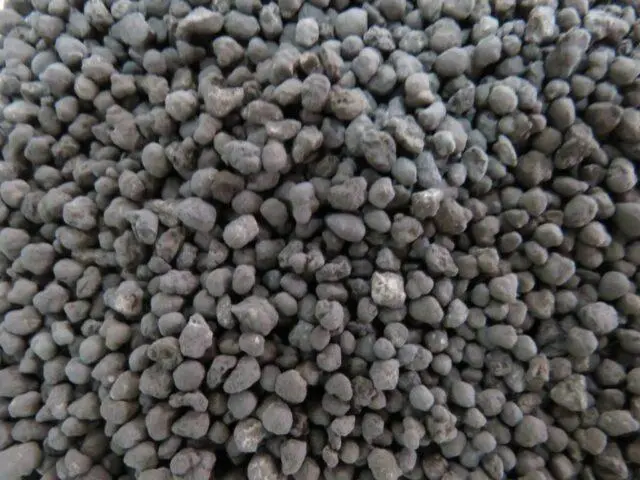
A characteristic sign of phosphorus deficiency is a reddish border on leaf plates.
Types of superphosphate
To feed cucumbers and other plants, different types of superphosphate are used, which differ in chemical composition and form of release. There are simple, double, ammoniated and granular compositions.
Simple
This type of top dressing for cucumbers is also called monophosphate (contains from 16% to 20% P2O5 in water soluble form). The top dressing also includes other components: sulfur – up to 10% and nitrogen – up to 8%. This type of superphosphate is widely used. It is enriched with phosphorus and is affordable.
Double
Double superphosphate is one of the most popular fertilizers for cucumbers. Unlike simple, it contains 2-2,5 times more phosphorus (P2O5 up to 45%), with which its name is connected. The composition of top dressing for cucumbers also includes magnesium and calcium. The substance effectively saturates the soil and is practically not washed out of it. This is especially important during the fruiting period, when cucumbers consume phosphorus in large quantities.
Granulated
Chemically, this is the same simple superphosphate. However, the production technology of granular fertilizer is different. It is obtained by diluting the monophosphate followed by the formation of granules. The mass fraction of phosphorus is about 30%, calcium is also present in the top dressing in the form of limestone.
Top dressing is used for preplant tillage and fertilization of cucumbers at all stages of growth. Moreover, it is better to apply it by watering under the root, and not by the foliar method. In this case, the mixture should be concentrated – 20 tablespoons of granules per 3 liters of hot water.
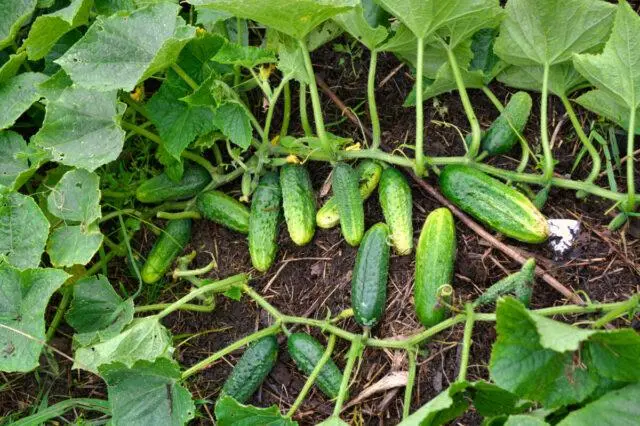
Granular superphosphate – an effective tool for the growth of cucumbers
Ammoniated
This is a complex fertilizer that contains several components at once:
- calcium – more than 50%;
- sulfur – 18%;
- phosphorus – 17%;
- nitrogen – 3%.
Top dressing is used not only for growth and productivity, but also to ensure the acid-base balance of the soil. Often soils become acidic, so they should be neutralized. In this regard, ammonia helps well, which is also present in superphosphate. To improve the neutralization effect, it is also recommended to use slaked lime, phosphate rock, humus or chalk.
How to dilute and apply superphosphate for cucumbers
In garden practice, superphosphate in the form of granules is most often used. If applied as a powder, the solution will turn cloudy, with a precipitate in the form of gypsum (calcium sulfate), which is more difficult to work with. The standard dosage for feeding cucumbers is 20 g per 1 m2.
To prepare the solution, proceed as follows:
- Weigh 350 g of superphosphate (on a scale).
- Prepare 3 liters of boiling water.
- The granules are added and everything is thoroughly mixed for 15 minutes so that they disperse almost completely.
- The resulting concentrate can be stored for several days. Before using it, you need to select 100 ml (half a glass) and dilute in 10 liters of water.
- Cucumbers are watered at the rate of 1 liter per plant (based on this, you can determine the total volume of the working solution).
Since a huge amount of the composition is not needed for the garden, it is recommended to prepare and dissolve 30 g of granules in 300 ml of hot water (large glass). This amount is enough to prepare a ready-made solution in a volume of 30 liters, i.e. for watering 30 bushes of cucumbers.
When digging make 45-50 g per 1 m2. If the soil is dug up in the spring, the amount is reduced to 40 g per 1 m2.
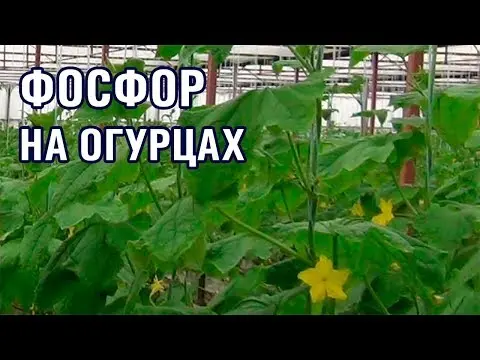
About 15 g of superphosphate is placed in a tablespoon
Feeding time
Top dressing is applied in several stages:
- Before planting seeds or seedlings of seedlings, the soil is dug up (in spring or autumn) and both phosphates and other fertilizers are embedded. For example, to process 1 m², you can take copper sulfate (0,2 g), superphosphate and potassium nitrate (5 g each).
- Seedlings are fed after the appearance of a pair of leaves or immediately after picking. At this point, not only phosphates are introduced, but also nitrogen in the form of saltpeter, urea or chicken manure, liquid manure.
- Further top dressing is given a few days after transplantation. From now on, you can make them on a weekly basis.
- The next application is planned for the beginning of flowering. To process one square meter, it is recommended to mix 45 g of superphosphate, 32 g of ammonium nitrate and 23 g of potassium nitrate.
- Then fertilizer is applied already at the fruiting stage. This can be done in a root and foliar way by processing the plants along the leaf. At the same time, the beds can be sprinkled with dry wood ash.
Features of top dressing
You can use superphosphate for cucumbers both in the open field and in the greenhouse. The concentrations and terms of application are the same, however, there are several differences.
In the greenhouse
In the greenhouse, cucumbers are fed with superphosphate at least four times per season with an interval of one week. It is recommended to use complex formulations, preferably organic. You can cook them yourself or purchase ready-made preparations, for example, “Complex-BIO” or “Pospeta”.
In open ground
When growing cucumbers in open ground, superphosphates are also applied several times:
- after transplanting seedlings;
- two weeks later;
- during the main fruiting (twice).
In this case, a complex composition is also used, but it can be both organic and mineral. For example, to process one square meter of landings, you can make the following mixture:
- superphosphate – 45 g;
- any saltpeter – 25 g;
- potassium salt – 15 g.
After a week break, mullein 1:10 or chicken manure 1:20 is added.
Superphosphate for cucumbers during the fruiting period
Superphosphate is used at all stages of the development of cucumbers, since plants are in great need of phosphorus. Experienced summer residents advise fertilizing several times a week. This is especially important during fruiting, because at this stage cucumbers require a large amount of nutrients, including nitrogen and potassium.
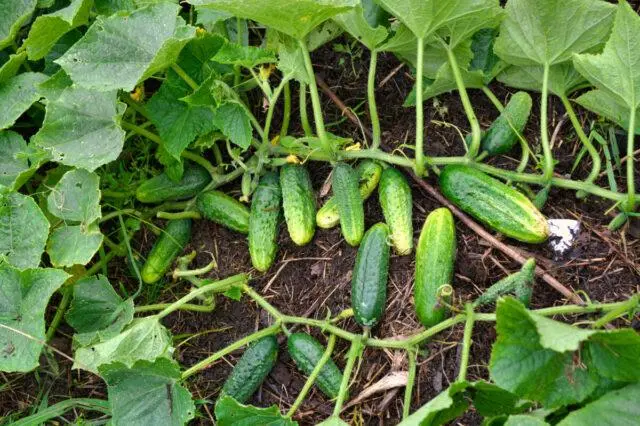
Superphosphate is especially important to use during the formation of cucumber fruits.
Therefore, in the fruiting phase, it is better to use a complex composition consisting of such components (per 10 liters);
- double superphosphate – 20 g;
- potassium nitrate – 25 g;
- urea – 50 g.
Each bush is watered with 1 liter of this mixture at least once a week. You can also carry out foliar feeding of cucumbers. In this case, the urea content is reduced to 10 g per 10 liters.
Some summer residents recommend giving superphosphate to cucumbers during fruiting on a daily basis. But in this case, top dressing should consist only of phosphates, since the frequent use of other components (for example, nitrogen) will harm plants and soil.
Safety measures
Phosphate top dressings are not dangerous for humans, plants and animals. However, certain safety precautions must be observed during operation.
- When working with a concentrated solution, gloves must be worn.
- During the preparation of the solution and the processing, access of children should be excluded.
- If the solution gets on the skin, it is enough to wash it off with a soapy composition. In case of contact with the eyes, they are washed with a not too strong pressure of running water.
- The repeated combination of superphosphate with urea leads to rapid acidification of the soil. Therefore, the use of such combinations is not recommended too often.
- Foliar application is done late in the evening or early in the morning, preferably in dry and calm weather.
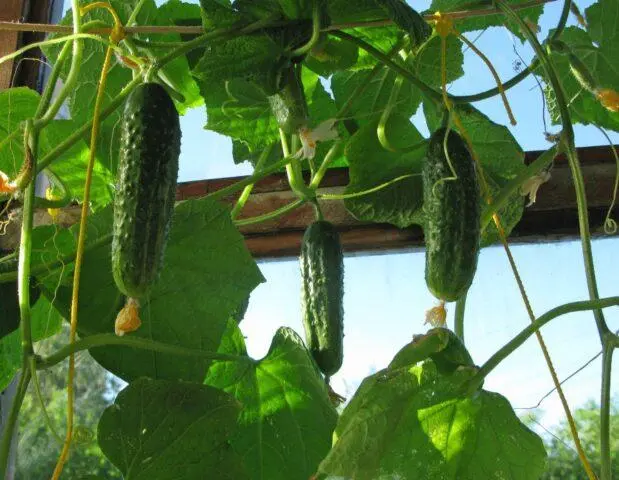
Processing seedlings in the greenhouse can be carried out in any weather
Conclusion
Superphosphate fertilizer for cucumbers is essential. Without it, plants become weaker, bloom worse, and the setting drops. As a result, the yield also decreases. Therefore, it is recommended to apply top dressing for cucumbers at least once a week.









